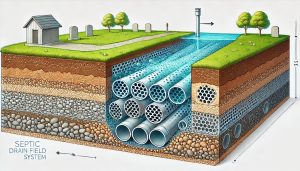Landscaping around septic drain fields is crucial for maintaining both the health of your septic system and the aesthetics of your property. Proper vegetation management can enhance the functionality of your septic system while preventing potential damage. In this article, we will explore effective landscaping tips for septic drain fields, focusing on plant selection, soil types, maintenance strategies, and common pitfalls to avoid. By understanding how to care for these areas, homeowners can ensure their septic systems operate efficiently while keeping their landscapes beautiful.
Table of Contents
- Understanding Septic Drain Fields
- The Function of a Septic Drain Field
- Importance of Landscaping Around Drain Fields
- Choosing the Right Vegetation
- Soil Types and Their Importance
- Testing Your Soil
- Maintenance Strategies
- Common Pitfalls to Avoid
- Septifix
- Septic Permit Links by State
Understanding Septic Drain Fields
Septic drain fields, also known as leach fields, are essential components of a septic system. They allow treated wastewater to percolate into the soil, where it is further filtered and purified. The effectiveness of a septic drain field depends largely on its design, the type of soil present, and the vegetation surrounding it. Properly managed drain fields can last for decades with minimal issues.
The Function of a Septic Drain Field
When wastewater exits the septic tank, it flows into the drain field through a series of perforated pipes buried in gravel or sand. The soil acts as a natural filter, breaking down harmful bacteria and nutrients before they reach groundwater sources. This process is vital for protecting both public health and the environment.
Importance of Landscaping Around Drain Fields
Landscaping plays a significant role in maintaining the efficiency of septic drain fields. Proper plant selection and soil management can enhance drainage, prevent erosion, and reduce the risk of system failure. Additionally, well-planned landscaping can improve the visual appeal of your property.
Choosing the Right Vegetation
Selecting appropriate plants is one of the most critical landscaping tips for septic drain fields. Here are some recommended options:
1. Native Grasses
Native grasses are ideal for septic drain fields because they require less water and maintenance compared to non-native species. They have deep root systems that help stabilize the soil while allowing water to percolate through effectively. Some excellent choices include:
- Buffalo Grass: Drought-resistant and low-maintenance.
- Blue Grama Grass: Thrives in various soil types and conditions.
2. Deep-Rooted Plants
Plants with deep root systems can help stabilize the soil without obstructing drainage. Consider including:
- Wildflowers: These add color and attract pollinators while providing minimal interference with drainage.
- Certain Shrubs: Low-growing shrubs like elderberry or serviceberry can be beneficial when planted at a safe distance from the drain field.
3. Avoid Trees
While trees provide shade and beauty, their extensive root systems can invade and damage the drain field. It’s best to avoid planting trees within 50 feet of your septic system to prevent potential issues.
4. Ground Covers
Low-growing ground covers can help prevent soil erosion while allowing water to infiltrate easily. Options include:
- Creeping Thyme: This hardy plant is drought-resistant and provides excellent ground coverage.
- Sedum: Another drought-tolerant option that thrives in poor soils.
Soil Types and Their Importance
Different soil types affect how well your drain field performs. Here’s a brief overview:
| Soil Type | Characteristics | Impact on Drain Field |
|---|---|---|
| Sandy | Well-draining but may leach nutrients quickly | Good drainage but requires monitoring |
| Clay | Poor drainage; retains water | Can lead to backups if not managed |
| Loamy | Balanced drainage and nutrient retention | Ideal for most vegetation |
Understanding your soil type is crucial for selecting appropriate plants and managing water effectively.
Testing Your Soil
Before planting, consider conducting a soil test to determine its composition and pH level. This information will help you choose plants that thrive in your specific conditions and guide you in amending the soil if necessary.
Maintenance Strategies
Regular maintenance is essential for keeping your septic drain field healthy. Here are some practical tips:
1. Mow Regularly
Keep grass around the drain field trimmed to prevent overgrowth. Tall grass can harbor pests and obstruct airflow, which is crucial for proper drainage.
2. Inspect for Erosion
Check for signs of soil erosion regularly, especially after heavy rains. Address any erosion promptly by adding mulch or planting additional ground cover plants to stabilize the area.
3. Limit Heavy Foot Traffic
Avoid compacting the soil by limiting activities in this area. Heavy foot traffic can damage vegetation and disrupt drainage patterns.
4. Water Wisely
Be mindful of irrigation practices near your drain field. Overwatering can saturate the area, leading to reduced effectiveness of the system. Use drip irrigation or soaker hoses to minimize excess water.
5. Fertilize Sparingly
If fertilization is necessary, use organic fertilizers sparingly around your drain field to avoid nutrient runoff that could overwhelm the system.
Common Pitfalls to Avoid
While landscaping around septic drain fields can enhance their functionality, there are common mistakes that homeowners should avoid:
1. Planting Invasive Species
Invasive plants can quickly take over an area, outcompeting native species and disrupting local ecosystems. Always choose native or non-invasive plants for your landscape.
2. Ignoring Drainage Patterns
Understanding how water flows across your property is crucial when planning landscaping around a drain field. Avoid creating barriers that could redirect water toward your septic system.
3. Overlooking Local Regulations
Many areas have specific regulations regarding landscaping near septic systems. Check with local authorities before making significant changes to ensure compliance with all guidelines.
Conclusion
Implementing effective landscaping tips for septic drain fields can significantly enhance their functionality and lifespan. By choosing the right vegetation, understanding soil types, and maintaining the area properly, homeowners can ensure their septic systems operate efficiently while contributing positively to their landscape’s beauty.
The Role of Perforated Pipes in Drain Fields
What Happens During a Pumping Service?
Septic Tanks vs. Sewer Systems | Choosing the Right Option
Directory | Virginia Septic Service Providers | Part 2
Directory | Virginia Septic Service Providers : Best Professionals | Part 1
Septic Treatments for Odor Control: Best Methods for Eliminating Unpleasant Smells
Septifix







